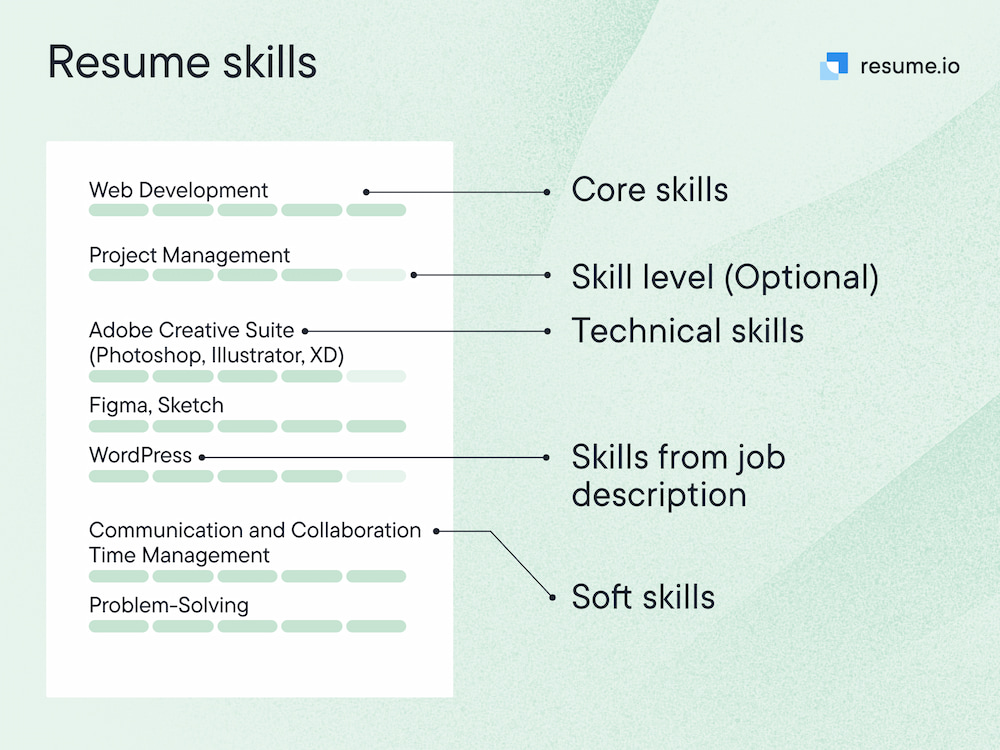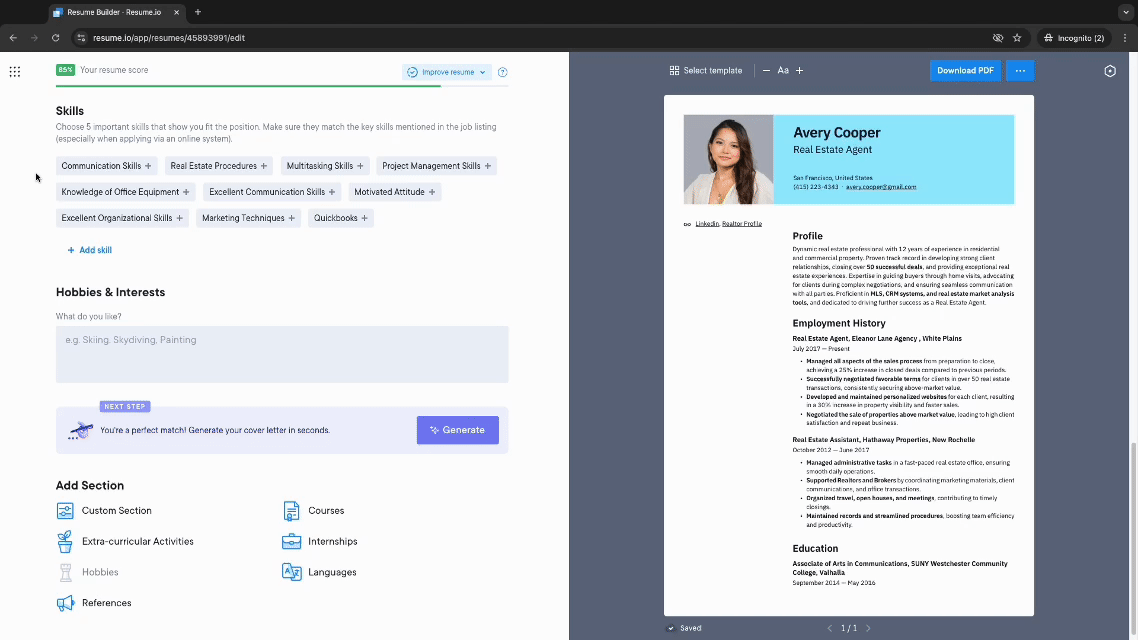A skills section is a given on any resume, but to boost the power of that section, you may choose to add your proficiency level to give employers a more honed representation of your abilities. But judging your own skills can be tough. You may be tempted to underplay or overplay your expertise level in an effort to impress.
So how do you go about creating an accurate resume that includes skill levels? In this blog, we’ll break down the answer to that question into the following topics:
- Categories of skills to list
- What are resume proficiency levels?
- How to rate your skill levels for a resume
- Ways to list skill levels on a resume
Before you begin to rate your skill levels, you need to create a list of all your attributes. Brainstorm any and all knowledge and abilities that you have, regardless of whether they seem relatable to the job. Keep this master list and add to it as you progress in your career. It will come in handy when you compile your skills list, but also when you get asked that common interview question: “What are your greatest skills?”
The 2 categories of skills
Once you’ve created your long list of skills, you need to organize it. There are two main types of skills:
Hard skills
Hard skills are those you learned for the job. In other words, if you can take a class to learn it and it applies directly to your profession, it’s a hard skill. Examples include computer software, rules and regulations, accounting procedures, graphic design, and languages.
Soft skills
Soft skills are interpersonal and general work qualities that are relatable to most jobs. Examples include communication, trustworthiness, reliability, problem solving, and organization.
Your resume should include a blend of both of these types of skills.
You may want to further divide your master list into categories of both hard and soft skills that will ensure you can easily create the best mix for your resume skill section. Below are example categories.
| Hard skills | Soft skills |
| Technical or computer | Communication |
| Industry knowledge | Presentation |
| Management | Sales |
| Analytical | Creativity |
What are the 4 resume proficiency levels?
Once you have impressed yourself with all the skills you have acquired in your life (not just your career because some of your most valuable soft skills are those you have developed in your relationships with others and in school), it’s time to think about how to rate your skill level.
Here are the four levels of skills you should use to rank yourself:
- Expert. You know this skill hands down, can guide others in using it, and feel 100% confident that any related issue that comes up, you can handle.
- Proficient. You use this skill regularly in your profession and are confident in your ability to tackle most situations. You can troubleshoot when something goes wrong, although you may have to turn to an expert on rare occasions.
- Intermediate. You’ve moved beyond the basics, but are still learning. As long as the task isn’t complex, you can complete it and do some basic troubleshooting.
- Beginner. You’ve just started learning a new skill and can perform some basics, but you can’t say that you could use this skill without assistance or more training.
Now that you have the definitions of skill levels, let’s look at how you can rank yourself within them
How to rate your skill levels for a resume
Many resume templates offer the option of ranking your skills to give recruiters a clearer picture of who you are as a candidate. This extra information requires more thought on your part, but will also help you find the right job fit.

Unless you really want to list a skill you believe is secondary to the position you seek, but adds to your candidacy, avoid choosing beginner-level skills.
Hard skills
Hard skills are easier to rate. You may even have taken an assessment test that tells you exactly where you fall on the proficiency scale of skill levels. Any skill that you have advanced certification in makes you proficient or expert—you’ve proved it by passing a class and earning a certificate.
If you’re wavering between two levels, you can see if there’s a quick assessment you can complete online or ask a colleague. You don’t want to take yourself out of the running by being too modest, but you also don’t want to exaggerate and find that you are in over your head at your new job.
Soft skills
Soft skills can be more difficult to rate because there’s no simple test for how well you communicate or organize your workday. One method is to break down the skill into its components and see how many of the components you have.
For example: Are you an active listener? Can you give feedback? Regularly communicate and share information with peers and other stakeholders? All of these are parts of communication skills.
How to list skill levels on a resume

- Decide on your format. If you have more than seven skills you wish to highlight, consider a resume template that allows for more space for this section. A hybrid resume format typically enlarges your skills section. While this may take some space from your other sections, in particular your employment history, if the job requires many technical abilities, this may be the way to go.
- Use a design element. The best way to list your skill levels on your resume is to use a visualized rating system, such as stars, a bar, or another graphic element. This visual addition helps to highlight your abilities and gives recruiters a quick way to see that your talents match the position. To give more weight to your skills, choose a template that uses not only a rating scale but also a background color or another spot design that attracts attention.
- List skills in order. Start with the skills in which you are an expert, and then list those in which you are proficient. Intermediate skills should fall at the bottom, but lean toward only listing these if they are mentioned as “nice to have” skills on the job listing.
- Personalize for each job. Your skills list is dependent upon the job you’re applying for. This is even more true when you rate your skills because each job prioritizes skills a bit differently. Make sure you match your skills to those desired by your targeted employer and remember that being overqualified can also eliminate you from the running.
While your skills section is an important element of your resume, you need to back up this listing with concrete examples within the rest of your document. Use your profile, employment history, and education sections to provide evidence that backs up your ratings and broadens the picture of what you can do with your skills that will make your prospective employer’s workday easier.
Key takeaways
The skills section offers valuable information at a glance to HR personnel. Taking the time to rank and rate your skill levels will also help you target jobs for which you are an excellent candidate.
- Before you can rate your proficiency levels for your resume, you need to know what all your skills are.
- An outstanding skills section includes proficiency levels in both hard and soft skills.
- A design element will help guide a recruiter’s eyes to your top-notch skills and proficiency levels.
- Use your entire resume to show off how you use your skills to do a great job.





